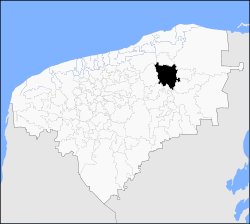Espita Municipality
Espita Municipality is one of the 106 subdivisions of the State of Yucatán in Mexico.[7] Its municipal seat is located in the City of Espita and is located on the Litoral Oriente (East Coast) or Region 1 of the state.[8] In 2005, the municipality had the 77th highest HDI in the state with 0.7320,[9] the same as Honduras in 2007.[10]
Espita | |
|---|---|
Municipality | |
 Coat of arms | |
 Location of the Municipality | |
| Country | |
| State | |
| Mexico Ind. | 1821 |
| Yucatan Est. | 1824 |
| Municipality Est. | 1921[1] |
| Government | |
| • Municipal President | José Luis Uc Moo (2010-2012)[2][3] ( |
| Area | |
| • Total | 496.91 km2 (191.86 sq mi) |
| [1] | |
| Elevation | 15 m (49 ft) |
| Population | |
| • Total | 14,432 |
| • Demonym | espitan |
| Time zone | UTC-6 (Central Standard Time) |
| • Summer (DST) | UTC-5 (Central Daylight Time) |
| Postal Code | 97730 |
| Area code(s) | 986 |
| INEGI Code | 31032 |
Location
This municipality is located in the eastern-part of the state. It is located between latitudes 20° 53' and 21° 08' north and longitudes 88° 16' and 88° 27' west.[1]
It borders the following municipalities: to the north Sucilá to the south Tinum and Uayma, on the east Temozón and Calotmul and the west Dzitas - Cenotillo.[1]
Demography
Education
| Type | Students | Teachers | Schools |
|---|---|---|---|
| Preschool education | 807 | 33 | 12 |
| Primary education | 2 566 | 87 | 16 |
| Secondary education | 808 | 63 | 5 |
| High school | 396 | 25 | 1 |
| Total | 4 577 | 208 | 34 |
| Source: Secretaría de Educación de Yucatán.[11] | |||
Communities
The Espita municipality has 17 communities and the municipal seat.[12] In 2005, only 7 of its 17 communities had more than 200 inhabitants. Together these 7 communities had a population of 3,605, which together with the municipal seat (10,758), was 14,363, i.e. the 99.52% of the total municipal population.
| Communities with over 200 people and their distance from the municipal seat | ||||
| Code | Community | Coordinates | Population | Distance |
|---|---|---|---|---|
| 310320002[13] | Holcá | 21°05′28″N 88°16′07″W | 501 | 9.95 km |
| 310320003[14] | Kunché | 20°54′35″N 88°18′16″W | 698 | 10.84 km |
| 310320004[15] | Nacuché | 20°55′22″N 88°17′45″W | 1.130 | 9.36 km |
| 310320005[16] | San Pedro Chenchelá | 20°52′29″N 88°18′51″W | 261 | 14.58 km |
| 310320007[17] | Tuzik | 21°06′44″N 88°28′18″W | 384 | 20.91 km |
| 310320008[18] | X-Ualtez | 21°07′20″N 88°28′22″W | 262 | 21.77 km |
| 310320009[19] | Xuilub | 20°55′00″N 88°25′12″W | 369 | 15.72 km |
| Source: INEGI,[6] Archivo Histórico de Localidaes.[20] | ||||
Landmarks
Architectural
Landmarks include:
- St. Joseph's Temple, built in the eighteenth century.
- The former Franciscan convent, built at the beginning of the sixteenth century.
- The Municipal Palace.[1]
Archaeological
The area called Pom.[1]
References
- "Nuestros municipios - Espita". Archived from the original on 2010-12-28. Retrieved 2009-11-11.
- PorEsto! (May 20, 2010). "Oficial el triunfo de José Luis Uc Moo". Yucatanalamano.com.
- IPEPAC. "Directorio de alcaldes electos" (PDF). Archived from the original (PDF) on September 16, 2011. Retrieved July 31, 2010.
- IPEPAC. "Alcaldías de Yucatán por partido político" (PDF). Archived from the original (PDF) on July 22, 2011. Retrieved July 31, 2010.
- "Encyclopedia of the Municipalities of Mexico: Yucatan". Archived from the original on 2008-11-20. Retrieved 2009-11-01.
- INEGI (2005). "Census Results by Locality". Archived from the original on 2011-07-22.
- Instituto Nacional de Estadística y Geografía. "Aspectos geográficos de Yucatán. División Municipal" (in Spanish). Archived from the original on July 22, 2011. Retrieved August 17, 2010.
- Instituto Nacional para el Federalismo y el Desarrollo Municipal. "Regionalización de Yucatán" (in Spanish). Enciclopedia de los Municipios de México. Archived from the original on June 16, 2011. Retrieved May 10, 2010.
- United Nations Development Programme. "Indicadores de Desarrollo Humano y Género en México 2000-2005" (PDF) (in Spanish). Archived from the original (PDF) on July 22, 2011. Retrieved August 12, 2010.
- United Nations Development Programme. "2009 Human Development Report" (PDF). p. 182. Retrieved August 12, 2010.
- SEEY. "Concentrado estadístico por Municipio". Archived from the original on July 22, 2011. Retrieved November 19, 2010.
- www.yucatan.gob.mx. "Información del municipio". Archived from the original on December 3, 2010. Retrieved August 18, 2010.
- INEGI. "Archivo Histórico de Localidades. Holcá". Archived from the original on July 22, 2011. Retrieved August 18, 2010.
- INEGI. "Archivo Histórico de Localidades. Kunché". Archived from the original on July 22, 2011. Retrieved August 18, 2010.
- INEGI. "Archivo Histórico de Localidades. Nacuché". Archived from the original on July 22, 2011. Retrieved August 18, 2010.
- INEGI. "Archivo Histórico de Localidades. San Pedro Chenchelá". Archived from the original on July 22, 2011. Retrieved August 18, 2010.
- INEGI. "Archivo Histórico de Localidades. Tuzik". Archived from the original on July 22, 2011. Retrieved August 18, 2010.
- INEGI. "Archivo Histórico de Localidades. X-Ualtez". Archived from the original on July 22, 2011. Retrieved August 18, 2010.
- INEGI. "Archivo Histórico de Localidades. Xuilub". Archived from the original on July 22, 2011. Retrieved August 18, 2010.
- INEGI. "Archivo Histórico de Localidades". Archived from the original on August 19, 2010. Retrieved August 18, 2010.

